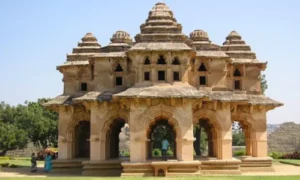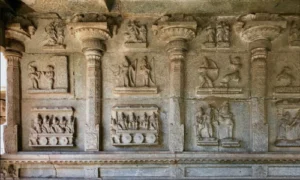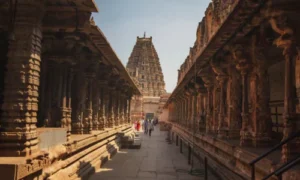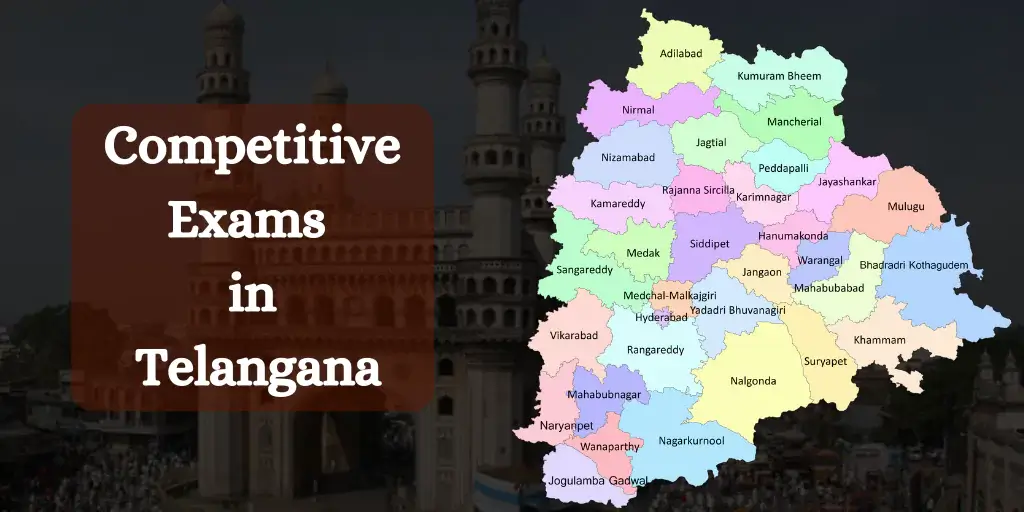Ever wondered how the Vijayanagara Empire rose to become one of the wealthiest and most powerful empires in Asia? In 16th-century South India, a single ruler transformed its destiny—his reign inspired poets, strengthened culture, and made even his enemies tremble in fear.
When you picture the Vijayanagara Empire, you’re looking at the pinnacle of medieval Indian prosperity, art and military might – all orchestrated by the legendary Krishnadevaraya.
You’ll discover how this “King of Kings” balanced military conquest with cultural renaissance, expanded his empire while nurturing literature, and built architectural wonders that still leave visitors breathless today.
But the real question that historians still debate is: how did a kingdom that seemed unstoppable suddenly begin its dramatic decline just decades after reaching such dizzying heights?
1. The Rise of the Vijayanagara Empire

A. Origins and founding of the empire
Ever wondered how the mighty Vijayanagara Empire began? Picture this: it’s 1336, and you’re witnessing the founding of what will become South India’s greatest kingdom. Brothers Harihara and Bukka, inspired by Saint Vidyaranya, established this Hindu stronghold against Muslim invasions.
B. Key rulers before Krishnadevaraya
Before Krishnadevaraya took the throne, you would’ve seen remarkable rulers shaping the empire’s foundation. King Devaraya I expanded territories, while his grandson Devaraya II turned the kingdom into a powerhouse with military reforms that you’d find impressive even by today’s standards.
2. Krishnadevaraya: The Legendary Ruler

Early life and ascension to the throne
When you look at Krishnadevaraya’s early years, you’ll find a prince born in 1471 to Tuluva dynasty rulers. You might be surprised how he rose to power in 1509 during a time of political chaos, quickly establishing himself as a force to reckon with in South India.
Military conquests and strategies
Ever wondered how Krishnadevaraya became so powerful? Your answer lies in his brilliant military tactics against the Deccan Sultanates. You’d be impressed by his leadership in battles and innovative use of cavalry that expanded Vijayanagara territory to its greatest extent.
3. Administrative Brilliance
A. Governance structure and innovations
You’ll be amazed at how Krishnadevaraya organised his empire into provinces called Rajyas, each under a governor or Nayak. His genius? He balanced central control with local autonomy, letting you see a system that maintained imperial unity while respecting regional differences.
B. Taxation and revenue systems
Ever wondered how Vijayanagara funded its grandeur? You’d pay taxes primarily on land and trade. Krishnadevaraya’s approach was surprisingly fair – he adjusted rates based on land fertility and irrigation access, ensuring you weren’t overburdened during droughts.
4. Cultural Renaissance
A. Literature and the Telugu golden age
You’ll discover that Krishnadevaraya himself authored the famous Telugu work “Amuktamalyada,” making him one of the eight Telugu literary giants. Your journey into Vijayanagara’s cultural renaissance reveals how Telugu literature flourished under royal patronage, with poets like Allasani Peddana being honoured as the “grandfather of Telugu poetry.”
B. Music and performing arts patronage
When you explore Vijayanagara’s artistic legacy, you’ll find the empire nurtured classical dance forms like Bharatanatyam and Kuchipudi. Your visits to temple complexes would have once featured elaborate performances, as Krishnadevaraya personally supported musicians, dancers, and dramatists who developed distinctive South Indian musical traditions.
5. Architectural Marvels

A. Distinctive Vijayanagara architectural style
When you visit Hampi today, you’re witnessing a unique blend of styles that defined Vijayanagara architecture. You’ll notice the massive stone structures featuring intricate carvings that combine Hindu and Islamic elements – a testament to Krishnadevaraya’s cultural openness.
B. Remarkable temples and public buildings
You can’t help but be amazed by the Vittala Temple with its iconic stone chariot and musical pillars. Your exploration of Hampi reveals how the empire’s prosperity under Krishnadevaraya translated into magnificent public spaces and temples that showcased both engineering brilliance and artistic mastery.
6. Economic Prosperity
A. Agricultural advancements
When visiting the Vijayanagara Empire during Krishnadevaraya’s rule, you’d marvel at its irrigation networks. You’d see tanks, canals, and wells that transformed arid lands into fertile fields. Your journey through the countryside would reveal farmers using advanced techniques that boosted rice, sugarcane, and cotton production.
B. Trade networks and foreign commerce
You’d find yourself amazed at the bustling ports where your goods could reach Arabia, Portugal, and China. Your trading ventures would benefit from Krishnadevaraya’s policies that protected merchants like you. Walking through markets, you’d spot Portuguese horses, Persian carpets, and Chinese silks – evidence of your empire’s global connections.
7. Legacy and Decline

A. Krishnadevaraya’s enduring cultural impact
You can still feel Krishnadevaraya’s influence when exploring South India today. His patronage of art, literature, and architecture shaped the cultural landscape forever. When you visit Hampi, you see his vision for a great civilisation.
B. Successors and challenges after his reign
After Krishnadevaraya’s death, you’d notice how quickly things changed. His successors couldn’t maintain the empire’s stability amid growing regional tensions. You might recognise this period as the beginning of the troubles that would eventually collapse the empire.
Also See: AP High Court Exam Syllabus
Conclusion
The Vijayanagara Empire under Krishnadevaraya truly represented a golden age in South Indian history. From its strategic rise as a bulwark against northern invasions to its transformation into a cultural and economic powerhouse, the empire demonstrated remarkable achievements in administration, art, architecture, and commerce. Krishnadevaraya’s enlightened leadership fostered religious tolerance, innovative governance systems, and patronage of multiple languages and art forms that defined this magnificent era.
As you explore the ruins at Hampi today, you can still witness the echoes of this splendid civilisation that once rivalled the greatest empires of its time. The legacy of Vijayanagara reminds you that visionary leadership coupled with cultural appreciation can create periods of extraordinary human achievement. Though eventually declining through succession challenges and military defeats, the empire’s contributions to Indian civilisation remain indelible, continuing to inspire and inform your understanding of South India’s rich historical tapestry.






